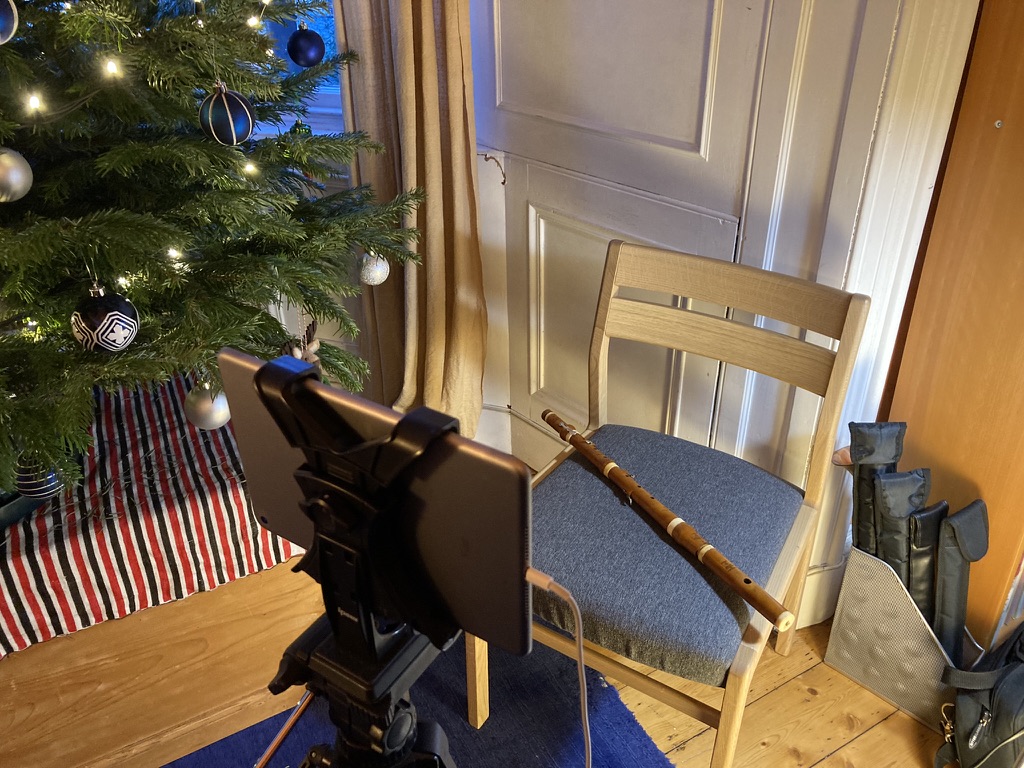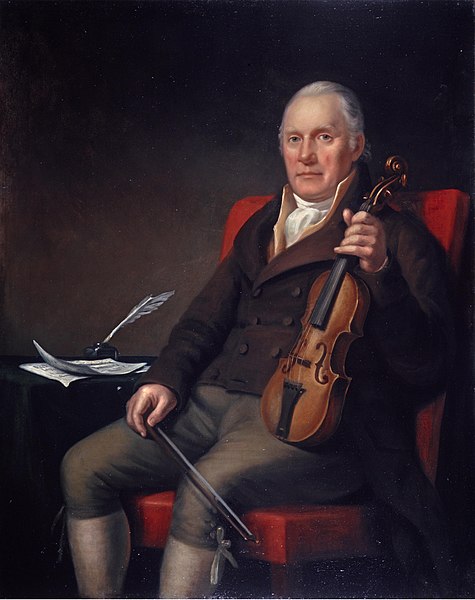
The recording of the videos was squeezed into a corner over the Christmas period. (c) Gordon Turnbull
FluteFling NE Tunebook Project: 04 The Road to Berwick / There’s Nae Harm Done Guidewife/ Mrs Brown of Linkwood
This fourth video of the NE Scotland Session Tunes Project features reels composed by 18th Century fiddle composer William Marshall.
For background to the project of 10 sets of tunes being recorded over 10 weeks, and to see the first video, start here. Alternatively, go straight to the videos on my Youtube channel.
You can download the free PDF of the sheet music here:
FluteFling Aberdeen 2019 NE Scotland Tunes
Marshall Reel Set
This fourth video in the project features three reels from the FluteFling NE Tunebook of Scottish session tunes for flute and whistle. I play these on my Astor flute in D.
William Marshall

William Marshall (1817) by John Moir (1775–1857), from the Scottish National Portrait Gallery
William Marshall (1748 – 1833) hailed from Fochabers in Aberdeenshire and is regarded as one of the most important fiddle composers in Scotland, alongside the Gow family, James Scott Skinner and others. Praised by Robert Burns, he worked for the Duke of Gordon and one of his roles was to compose music for the Duke during a golden age of Scottish music.
- Wikipedia has further information, as has The Traditional Tune Archive.
- The National Library of Scotland has several collections online that include William Marshall tunes.
- Music Scotland has modern editions of his collections for sale.
Aberdeenshire fiddler Paul Anderson has a YouTube project where he goes through every single William Marshall composition once so you can hear how they should sound. His channel is worth exploring, and is recommended for anyone curious about the strong NE Scotland fiddle style.
About the tunes
This set of reels presents some tricky problems for flute and whistle players. I didn’t know any of these tunes prior to this project, and it will take a while longer before they are completely fluent under my fingers.
This is true of course for any newly learned tune and the process for me is also slower when I learn from printed music than if I learn by ear. The next stage is to try playing the tune away from the music. There are a few ways to do this. I tend to keep the sheet music nearby for reference and go over the tune, pausing at any sticky transitions between the phrases, repeating them and slowing down to encourage the fingers to move correctly.
If you are particularly reliant upon the sheet music, try placing the music stand progressively further away from you as you go over the tune. The individual notes become harder to make out, but you will still see the general rise and fall of the melody. Surprisingly, your brain already knows what to do and at one point you will reach the sweet spot where it becomes harder to read the music than it is to remember it. It’s a process of trusting yourself and developing confidence, but definitely worth persevering with as you develop your skill in this area.
The next key stage for me is to move away from visualising the printed music and instead to understand the feel of the tune. This may take a while and the incipits in the PDF can prompt the recall of the opening bars to help trigger the phrases that come next.
Reels are played with a bit of pace, but don’t be tempted to race away with them. All three of these tunes have dotted phrases and keeping them slower allows you to better integrate them into the music. When played faster, there is less time for each note, dotted or otherwise, and the rhythm tends to become ironed out. And of course, speeding up is a common feature of sessions, so practising and learning slower is the opportunity to keep your technique secure
The Road to Berwick is in D and was first published in 1781. It was renamed The Buck of the Cabrach in an 1822 collection. Cabrach is an area near Fochabers in Aberdeenshire, whereas Berwick probably refers to Berwick upon Tweed in Northumberland, right on the Border with Scotland.
Points to be aware of when learning this tune:
- Octave drops: e-E and d-D
- The ascending phrase in the penultimate bar of the B part could become confused with the corresponding bar in There’s Nae Harm Done Goodwife (the second tune). Consider taking time to work on both of these and how they connect to the preceding phrases of their respective tunes.
Also published in 1781, There’s Nae Harm Done Guidewife is also in D and was possibly dedicated to his wife. See The Fiddler’s Companion (a precursor to the Traditional Tune Archive) for some more information. Note that there are a few different spellings of the title — Guidewife/ Guidwife/ Goodwife — the PDF for this project uses two different spellings, for example.
Points to be aware of with this tune:
- The opening bars of a tune in a set are important in communicating a change to other musicians and to dancers and should be strong. In the A part this combines octave jumps and snaps with use of the G# key that gives the rising phrase an extra lift. It can be tricky but is effective.
- Where a passage presents problems, work on it in isolation. Take each bar on its own and then combine them with others to get them to work together. In this instance, understanding where the tune goes from there will help make this a secure opening.
- The B part is relatively straightforward, although again, be aware of the penultimate bar and its similarity to The Road to Berwick. Once more, consider taking time to work on both of these and how they connect to the preceding phrases of their respective tunes.
Mrs Brown of Linkwood is in E minor and was possibly first published in 1822. The title honours a woman associated with the founding of the Linkwood Distillery in Elgin, which still still produces whisky to this day.
The reel runs easily, almost like some Irish polkas, and has a snapped phrase and a phrase that uses D#, both of which recur within the melody.
The use of D# ties the tune in with musical tastes and sensibilities of the 18th Century. It appears in several tunes of that period and also in the classical music of the time. I have come across some tunes where this has been dropped in more recent times, resulting in more than one version of a tune.
If you don’t have a D#/ Eb key, the tune still makes musical sense and it would be possible to play it with others if they had also understood that the D# is not to be played. However, it would not only lack the lift that the D# phrase introduces but also clash if others were playing the D#.
Similarly, this version in the National Library of Scotland has more dotted phrases that are not in the version we are learning and to my mind give it a stronger feel of modern Irish polkas.
I mention the Irish connection not because I think that the tune is somehow directly related to Irish music, but because the large numbers of flute players in Ireland makes it easier to find examples of how such phrases might be played. As flute players we can then use our judgement to bring that into Scottish playing where we think it can be effective. If you’re looking for an introduction to Irish flute playing, there are many guides online, but begin with Brad Hurley’s site.
Be sure to check out John McKenna, who was very influential in the early 20th Century. Some of his playing of Irish polkas includes tunes that Scottish musicians would recognise and his breathing and rhythm are of particular interest to flute players in Scotland. Here’s something I wrote about him a few years ago.
More than one version of a tune?
The other lesson here is that there tends to be more than one version of any tune played in traditional music. This could be due to different instruments, regional and individual styles or the folk process shaping it across the years and centuries. As so much of Scottish music has been in print for a long period, different editorial hands have also been involved, sometimes changing a title or making adjustments to suit personal or audience taste and not always in a way that appeals to our times. Sometimes too, there are just plain mistakes and errors that are then copied and repeated.
So, be aware when playing with others, that they may play the tune differently to you. This may be that they have a different version, their instrument is different or their individual style is (e.g. they have been influenced by different musicians).
In sessions, deference is given to the musician that starts the tune and the trick then is to get in step with them by adapting your playing. If they aren’t a confident player, then doing so supports them and avoids dominating their music. Entrainment is how musical communities and styles evolve and develop. There’s there’s quite a science behind it as this study from the University of Durham shows.
There’s also plenty of discussion about session etiquette to be found online, much of it heated.
Ten weeks of videos
Over a 10 week or so period, I am recording and uploading to YouTube a set of tunes from the PDF roughly once a week. The aim is to introduce the tunes, point out some techniques along the way and then play them as a set as I might play them in a session.
As I go along, I’ll take in suggestions to improve the sound and presentation and get back into the way of teaching again. There is an in-built slow down function in YouTube and the PDF is available to everyone, so why not join me on the journey?
